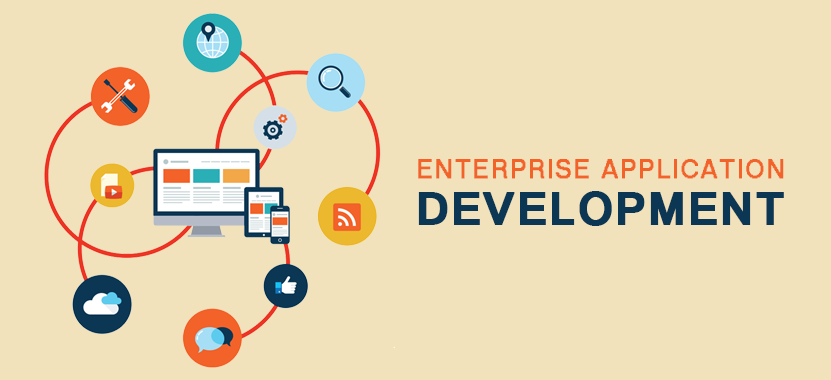An enterprise is a business organization which sells its services or products for the motive of earning profits. The enterprise can contain different departments like sales, manufacturing, human resources, etc. The employees and professionals of a particular department perform specific tasks, operations and processes. The different departments also collaborate with each other to meet the common objectives of the enterprise. Apart from for-profit enterprises, non-profit enterprises also exist. Enterprises can be of different sizes, belong to different industries and can differ in various other aspects.
What is an enterprise application?

Though enterprises are of various types, all of them use an enterprise application which is a kind of software. The enterprise application helps to integrate various operations and processes that are performed by different departments in an organization like accounting, resource planning, sales and distribution, logistics, etc. It helps to bring together the whole organization.
The application automates various business processes in the organization and allows data to be accessed in real time from any location. Also, it enables sharing as well as updating of data and information in real time. The use of the application for the organization’s planning, management and administration eventually leads to improvement of its productivity and enhancement of its ROI.
Building an enterprise application is a challenging affair due to the increased complexity and large size of the application besides other things. Let us find out the reasons which make enterprise application development challenging:-
1. Complexity
An enterprise application consists of many component systems like sales, customer information management, supply chain management besides others which tend to increase the size of the application and make it more complex. Also, the subsystems in an enterprise application may block each other. Making the systems work synergistically with each other adds up to the challenge of building the application.
Also Read: Why Dot Net is Most Preferred for Enterprise Application Development?
2. Changing business requirements
While developers are building an enterprise application for a business, its requirements for the application may change due to various reasons like it adopting a new technology, economic disruptions like fiscal deficits, loss of markets, etc., introduction of new workflows and requirements after feedback and analysis and the business getting acquired or it merges with another business. Also, different departments in a business may have requirements which change frequently and some of them may be contradictory in nature.
Such requirements tend to increase costs and time in an enterprise application development project. In order to accommodate these changing requirements in the application, it needs to have a flexible and scalable architecture. The application that is flexible can work under all kinds of conditions. Scalability allows the application to adapt to the increased size and needs of the organization.
3. Security

Companies store their crucial and confidential data and information in a central database. Due to malicious computer programs like malware and clickjacking used by hackers and cybercriminals, this data and information may get destroyed or leaked and fall into their hands. This may also happen due to hardware failure. To avoid data leakage or destruction, developers need to install the necessary security features into an enterprise application like setting permissions for restricting users’ access to data, SSL encryption, unwritable file system, X-frame options, multifactor authentication and biometric authentication.
The developers can also employ interactive application security testing for lessening the risks to security. They also need to update the software with the latest security patches and implement the same security levels across all the platforms that are being used by an organization.
Want to build an enterprise application for your business? Matrid Technologies, a software developer company offers proficient enterprise application developers for businesses of all kinds and sizes. CONTACT US TODAY !
4. Managing an increased amount of data

The data used by business organizations continues to drastically increase in terms of volume year after year. This consequently increases their network, data centre and storage costs and affects the experience of users due to web pages and applications taking a longer time to load. It is a challenge for businesses to store humongous data and manage it in an intelligent manner.
To manage this data in a better way, developers need to find the precise location of the data from various sub-systems of the enterprise application. This helps them avoid the use of repetitive data in an organization. After curating, organizing and centralizing of the data is done, it can be used effectively in data related projects. These projects provide executives and administrators of the organization useful insights about improving its productivity.
5. Interoperability

An enterprise application has to link smartly with other systems used in an organization like a payroll system, leave management system, customer management system, sales system, etc. All the systems have to integrate and link well with each other. Linking is important for maintaining consistency across all functions and for achieving easy sharing and use of the organization’s data. The enterprise software development company entrusted with the job of building the enterprise application needs to carefully design the application for heterogenous environments that make use of dissimilar systems.
6. Creating an engaging interface and experience for users

Another challenge before developers is to build an aesthetically appealing, comfortable and engaging interface which attracts end users in an organization to use the enterprise application. This will ultimately result in the organization getting more value from the application. Also, the developers need to add small details to the application for rendering its navigation and accessibility easier. This will eventually help to satisfy the employees of the organization and increase their productivity.
7. Increased time and cost

Building an enterprise application can take a significant amount of time and money. The time of development can be around 5-6 months. Incorporating the application in an organization and integrating it with various other systems used by the organization also takes time. So building the application in less time and costs remains a challenge for developers. Following the modular approach in an enterprise application development project can help them reduce time by around one-third and thus save a lot of money for the concerned organization. A modular architecture uses blocks of code which are already made and linked together accordingly.
8. Low return on investment

In spite of a business organization’s executives and administrators doing detailed planning over the building of the enterprise application and spending enough money on maintaining it and other associated expenditures, the application may still fail to give expected results in terms of improving employees’ productivity and sales cycle and optimizing and smoothing the internal processes of the organization. To avoid this, the organization needs to clearly define the goal of the application during its design and development phase. Also, measurements and comparisons need to be done on a regular basis to determine the real value of the application.
9. Choosing the right technology
Selecting the right technology plays a critical role in the success of an enterprise application. So developers need to thoroughly analyse the needs of an organization and the platform it uses to decide which specific technology they should employ for building the application. While some applications are used for particular platforms, others are used for cross-platforms. The use of three devices, namely Android, iOS and Windows has become widespread nowadays. These devices are equipped with different operating systems. Developers should keep this thing in mind while building an enterprise application for an organization.
10. Not collaborating with users
Most of the times developers build an enterprise application without collaborating with the users in an organization who are going to use the application. As a result, the application may not have the necessary features and it may affect the experience of end users. This eventually leads to the failure of the application.
Now, you have become aware of the various challenges faced by developers in building an enterprise application for a business organization. To effectively resolve the above stated challenges and build a secure, scalable and flexible enterprise application that well integrates and smoothens your business processes and operations and allows sharing of data in real time from different locations, you need to hire dot net developer from a proficient software development firm like Matrid Technologies.








Leave A Comment